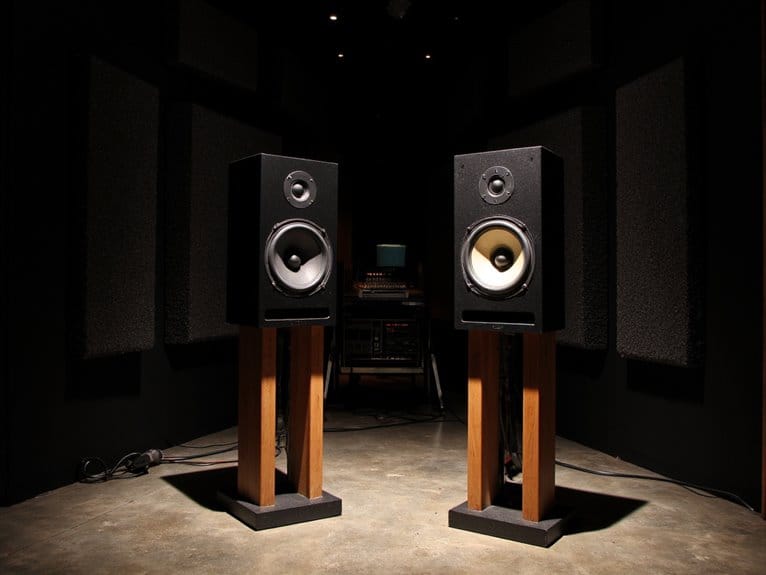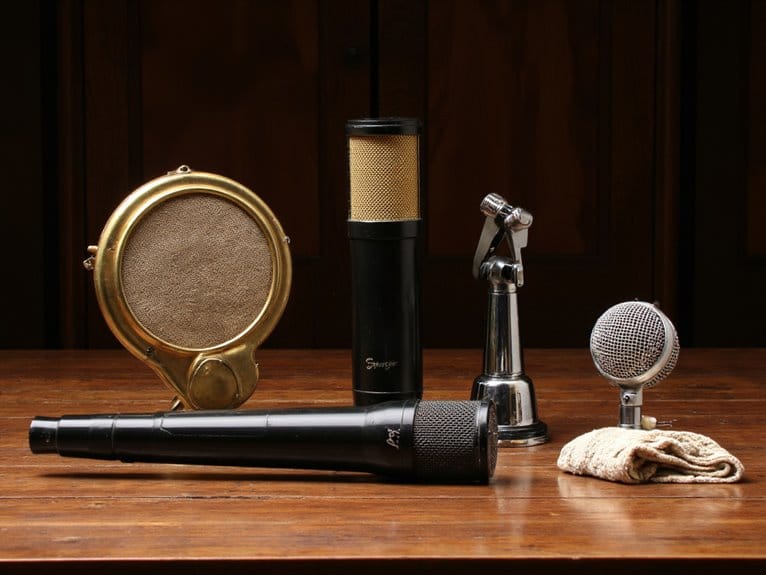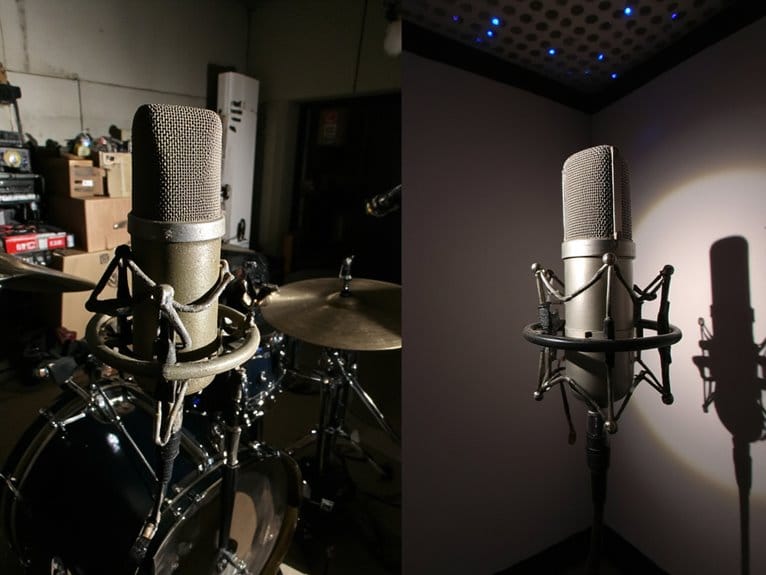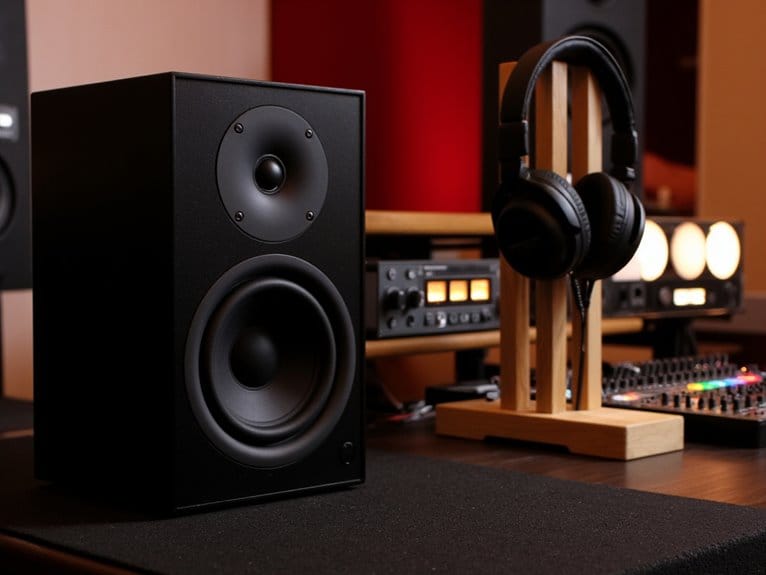Understanding Headphone Amplifiers in Audio Gear
Headphone amplifiers transform weak audio signals from your devices into robust power that matches your headphones’ impedance requirements, typically ranging from 16 to 600 ohms. You’ll notice improved clarity and detail since dedicated amps provide proper voltage output, unlike attenuated signals from speaker outputs that limit quality. High-impedance headphones above 100 ohms require dedicated amplification, while low-impedance models work with most devices but still benefit from quality amplification that delivers at least 1W of clean power for ideal dynamics and performance specifications you should understand.
We are supported by our audience. When you purchase through links on our site, we may earn an affiliate commission, at no extra cost for you. Learn more.
Notable Insights
- Headphone amplifiers boost weak audio signals to proper power levels, enhancing clarity and detail for better sound quality.
- Optimal impedance matching requires amplifier output impedance to be one-eighth of headphone impedance for ideal signal integrity.
- High-impedance headphones (100+ ohms) need dedicated amplification, while low-impedance headphones (8-50 ohms) work with most devices.
- Quality amplifiers deliver at least 1W clean power with specifications like sub-0.0025% distortion and wide frequency response.
- Modern amplifiers feature DSP customization, Class D efficiency improvements, and portable designs rivaling desktop performance levels.
What Are Headphone Amplifiers and Why Do They Matter
The thumping bass line in your favorite track suddenly loses its punch when you switch from speakers to headphones, and that’s where headphone amplifiers step in to bridge the gap between your audio source and your ears.
That disappointing moment when your headphones can’t deliver the audio punch your speakers effortlessly provide reveals why amplification matters.
These specialized electronic circuits transform weak signals from your phone, laptop, or audio interface into robust power that drives headphones properly, compensating for impedance variations from 16 to 600 ohms.
Unlike speaker amps that fill rooms with sound, headphone amplifiers work within the intimate confines of your ear cavity, requiring less power but demanding precision.
Many cheaper options use attenuated signals from speaker outputs rather than dedicated circuitry, which significantly limits the overall audio quality you can achieve.
Different amplifier types offer varying portability benefits, from desktop units delivering maximum fidelity to pocket-sized models balancing convenience with performance, ensuring your high-impedance headphones reach their full potential. Dedicated headphone amplifiers improve clarity and detail in your music, preventing the lifeless sound that often plagues underpowered headphones.
The Science Behind Impedance Matching in Audio Systems
Behind every perfectly matched headphone and amplifier pairing lies a fundamental electrical principle that I’ve watched countless audio enthusiasts either masterfully exploit or completely misunderstand throughout my years in the industry.
Impedance matching isn’t about maximum power transfer—it’s about ideal signal integrity and clean electrical flow between your components.
The golden rule I’ve learned is simple: your amplifier’s output impedance should be roughly one-eighth of your headphones’ impedance for the best impedance benefits.
High-impedance headphones above 100 ohms demand dedicated amplification to release their potential, while low-impedance models under 100 ohms will happily run off most devices. When mismatches occur, the consequences extend beyond poor audio quality to potential equipment overheating and permanent damage to your gear.
Modern active amplifiers handle varying loads gracefully, but proper matching still eliminates distortion, guarantees even frequency response, and maximizes the fidelity you’re paying for. This bridging approach preserves voltage transfer and maintains audio fidelity across different headphone impedances.
High-Impedance Vs Low-Impedance Headphones: Key Differences
When you’re shopping for headphones, you’ll encounter two distinct categories based on their electrical resistance: low-impedance models typically ranging from 8 to 50 ohms, and high-impedance variants that usually exceed 50 ohms, often reaching 100 ohms or higher in professional applications.
These impedance ratings aren’t just arbitrary numbers on spec sheets—they directly determine how much power your headphones need to reach ideal volume levels, with high-impedance models requiring markedly more voltage to achieve the same loudness as their low-impedance counterparts.
Understanding these fundamental differences becomes essential when selecting compatible amplification equipment, since mismatched pairings can result in underwhelming performance, insufficient volume, or even potential damage to your audio gear. The efficiency of sound production varies significantly between these impedance categories, affecting how well your headphones convert electrical signals into audible sound waves. High-impedance headphones provide better signal-to-noise ratio compared to low-impedance models, resulting in cleaner audio reproduction with reduced background interference.
Impedance Ratings Explained
Understanding impedance ratings has been one of those audio concepts that I’ve found genuinely separates casual listeners from those who dive deep into headphone performance.
It’s really about how much electrical resistance your headphones present to the audio source driving them.
Different headphone types showcase varying impedance requirements that directly affect their sound signatures, with measurements ranging from 8 Ohms to 600 Ohms or higher.
You’ll encounter three primary categories that determine compatibility with your audio equipment.
- Low impedance (8-50 Ohms) works efficiently with smartphones, tablets, and portable devices
- Mid-range impedance (33-100 Ohms) benefits from amplification but remains somewhat portable-friendly
- High impedance (100+ Ohms) requires dedicated amplifiers for peak performance
- Professional studio headphones typically feature higher impedance ratings for equipment compatibility
- Consumer headphones prioritize lower impedance for convenience and universal device compatibility
High impedance headphones often deliver more accurate sound reproduction compared to their low impedance counterparts, though they come at a premium price point. Most headphones maintain relatively flat impedance across the audible frequency spectrum, which helps ensure consistent performance.
Amplifier Matching Requirements
Now that you’ve grasped how impedance ratings work, the real challenge becomes matching your headphones with amplifiers that’ll actually release their potential.
I’ve learned through plenty of trial and error that getting this pairing wrong can leave even expensive headphones sounding flat or distorted.
The golden rule I follow involves impedance ratios where your headphone impedance should be at least eight times higher than your amplifier’s output impedance.
High-impedance headphones, typically 250-600 ohms, demand amplifier configurations with robust voltage output and low output impedance, while low-impedance models under 50 ohms work best with amplifiers having output impedance around 4 ohms or less. Different driver types like planar magnetic and dynamic headphones also present varying amplification requirements even when they share similar impedance ratings.
This ensures ideal power transfer and minimal distortion across your entire frequency range. A quality headphone amplifier typically needs to deliver 1W of clean power to maintain proper sound dynamics and prevent performance degradation.
Benefits of Dedicated Headphone Amplifiers Over Built-in Options
Most audio devices include basic headphone outputs that’ll get the job done, but they’re often afterthoughts in the overall design, squeezed into devices primarily built for other purposes like streaming, gaming, or general entertainment.
Most built-in headphone outputs are design afterthoughts, compromised by devices focused on entirely different primary functions.
When you invest in a dedicated headphone amplifier, you’re fundamentally giving your headphones the specialized attention they deserve, which directly impacts both headphone comfort during extended listening sessions and your ability to tailor the sound to your specific audio preferences.
Here’s what you’ll gain with a dedicated unit:
- Higher output power – drives demanding headphones without strain or distortion
- Lower output impedance – typically under 1Ω for better driver control
- Reduced interference – isolated circuits minimize electromagnetic noise and background hiss
- Enhanced compatibility – multiple input/output options support various sources and headphone types
- Improved fidelity – preserves dynamic range and reveals subtle details in your recordings
Common Distortion Issues and How to Avoid Them
Even the most perfectly matched amplifier and headphone combination can fall victim to distortion issues that’ll transform your carefully curated listening experience into something resembling audio played through a tin can.
Crossover distortion causes the most noticeable sonic degradation, particularly in push-pull amplifiers where components switch on and off, creating audible gaps in signal continuity. You’ll want to guarantee proper biasing and avoid overdriving your equipment beyond its capabilities, as these factors exacerbate existing distortion problems.
I recommend conducting regular total harmonic analysis using test tones to quantify distortion levels objectively. Impedance matching between your headphones and amplifier remains essential, while maintaining appropriate gain settings and utilizing negative feedback techniques can stabilize performance, ultimately preserving the signal integrity you’ve invested in achieving.
Frequently Asked Questions
Can Headphone Amplifiers Damage My Headphones if the Power Output Is Too High?
Yes, amplifiers can potentially damage your headphones if you’re not careful with volume control, though it’s less common than you’d think.
While power ratings indicate safety thresholds, the real culprit is usually sustained high volume rather than brief dynamic peaks.
I’ve found that respecting headphone safety limits through reasonable listening levels protects your drivers from overheating, mechanical failure, and distortion, regardless of your amp’s maximum output capability
Can I Connect Multiple Headphones to a Single Headphone Amplifier Simultaneously?
You can connect multiple headphones to a single amplifier, but headphone sharing comes with trade-offs I’ve learned through experience.
Using splitters distributes power between headphones, reducing volume and potentially compromising audio quality, especially with high-impedance models.
While some amplifiers feature multiple outputs, they’re rarely designed for simultaneous use.
For best performance, I’d recommend dedicated multi-headphone systems or wireless solutions over splitting a single amplifier output.
On a final note
Now that you’ve explored the technical landscape of headphone amplification, from impedance matching to distortion characteristics, you’re equipped to make informed decisions about your audio setup. Whether you’re considering a budget-friendly option or investing in premium gear, remember that the best amplifier isn’t necessarily the most expensive one—it’s the one that properly matches your headphones’ requirements and your listening preferences.







